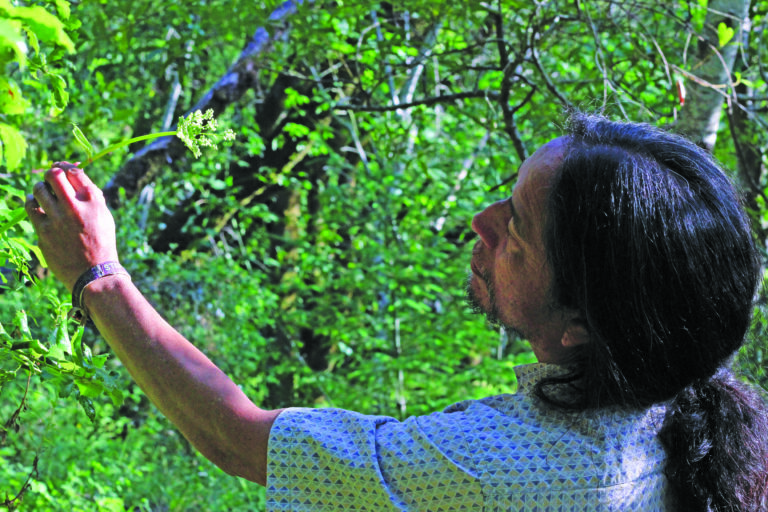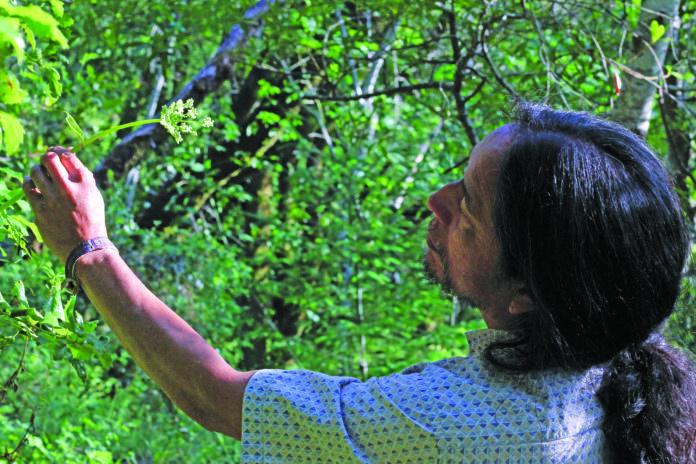On a recent late afternoon in Ross, I make my way up a lush trail bursting with horsetail, wild strawberries, yerba buena, trillium, wild roses and irises, Pedicularis, dead nettle, thistle and ferns. I’m hiking from the parking lot at Natalie Coffin Greene Park toward Phoenix Lake with Edward Willie. We’re in search of angelica, and Willie says there is a sizeable patch toward the top of the trail.
Willie is a local ecologist and biodiversity expert who lives in Santa Rosa and works in San Anselmo. A Native Californian (of Pomo, Wintu, Paiute and Wailaki ancestry), he’s taught herbalism, permaculture and indigenous knowledge at various California venues for decades, including at the annual Bioneers Conference and the Buckeye Gathering, where he is a core organizer.
Today, he’s teaching me a few things.
Known for its abundant biodiversity, Marin County is a magnet for Bay Area foragers and foraging classes. Groups and individuals can be seen combing through Marin’s wild places, gathering edible and medicinal plants like mushrooms, seaweed, elderberries, nettle and more.
But with so many residents and weekend visitors plucking readily available edibles from hillsides, beaches and open fields, how sustainable is the practice of foraging? And are there ethical principles or laws in place to keep in mind while out gathering wild foods and medicine? And what does someone like Willie think about it all?
“Everybody’s doing it wrong. In order to do it right, they would need to call that place their home, and here in modern society they’re not living in a place for generation after generation,” he says. “People need to sit with a plant. You can’t just come and walk around picking plants. That’s not the right way to do it.”
Willie stresses that there is much more to be aware of than just picking 10 percent of a patch of wild plants—the rule of thumb standard that most herbalists adhere to. There is another level of responsibility to these plants, he says, which is how to tend to a particular patch. “You have to take care of a whole ecosystem. You can’t just take care of one plant,” he says. “You’ve got to take care of the whole area where that plant is growing, which means you have to learn about everything.”
And there is certainly a lot to learn.
Cheryl Fromholzer, an herbalist, herb teacher and co-owner of Gathering Thyme in San Rafael teaches plant identification walks throughout Marin. And while she appreciates the amount of wild herbal medicine and native plants growing across the Marin landscape, she doesn’t necessarily advocate foraging.
“Foraging and herbalism, to me, are two different camps. There are people who wildcraft, who understand the sustainability issues, and then there are people who wildcraft who were never taught sustainability issues and don’t really understand,” she says. “If you’re not trained as an herbalist, but rather you do a foraging workshop, how much are you really going to learn?”
Fromholzer is concerned that not all foragers are taught the ethics of land harvesting, something she stresses to her students, customers and clients at Gathering Thyme.
“With [plant] medicine, we want to make sure that it’s not just around but that it proliferates,” she adds.
She also points out that some plants are at higher risk for negative impact from foraging than others. One, in particular, is chickweed. The plant, which is often used for ground cover, grows on slender stems with delicate white flowers poking out from the top of a small spread of oval leaves. Fromholzer says that the population of chickweed has declined in certain parts of Marin because of foraging; if harvested before the plants go to seed, there are fewer the following year.
Chickweed, she says, is a great spring green and a super food. It’s good for spring cleanses and because of its cooling properties, it can help with hot, rashy skin conditions.
“But most people don’t know it that way. They just think it’s kind of trendy and cool to put chickweed in your salad,” she says. “I don’t mean to bash foragers, and I’m hoping that the foragers have some sense of sustainability and know what they’re actually eating.”
Trillium is another that Fromholzer is concerned about. The perennial herb grows from rhizomes and is easily identified by three leaves and its single, three-petaled flower standing an inch or two above the leaves on a stem. Trillium roots are the most commonly used part of the plant when it comes to medicine, and have been known to alleviate a wide array of ailments including diarrhea, menstrual cramps, arthritis and even eye infections. Yet Fromholzer warns that harvesting trillium roots can kill this delicate plant. Some herbalists say that the plants are so fragile, that even removing a single leaf can kill them, and in some parts of Canada, it is illegal to damage them.
“Trillium is a plant that I don’t even use as an herbalist because I feel that its populations are dwindling, not only due to urban sprawl, but due to environmental pollution,” she says.
Environmental pollution should also be considered before foraging. Many esteemed herbal programs teach that gathering herbs on heavily trafficked roadsides, near streams that could be polluted and even near conventional farms that rely on pesticides for agricultural use should all be avoided. Most plants have the tendency to absorb toxins, which can lead to serious issues for the consumer.
On the other hand, some plants are just naturally toxic, making plant identification skills crucial for anyone heading out to collect herbal medicine and edibles.
The apiaceae family includes several culinary herbs and medicinal plants like cow parsnip and angelica. It also has poison hemlock. Fromholzer says Marin County has seen a couple of instances of hemlock poisoning in recent years, which she believes is the result of a growing population of foragers. Fromholzer often tests her herb students with botany identification, proving the point that even knowledgeable herbalists and wildcrafters can make mistakes.
“I bring in wild plants and I ask people to share the common name, the Latin name, what family it’s in and one medicinal use. And I usually put poison hemlock in there,” she says. “And even herb students sometimes are like, ‘Oh that’s Humira.’ And I’m like, ‘Oops, you’re dead.’”
Back on the trail with Willie, he points to another plant that foragers should be cautious with.
Pedicularis is a plant that is often used for anxiety and also acts as a “community organizer” of the body systems, as Willie describes it.
“It’s also semi-parasitic, so it leeches medicinal qualities off other plants, good and bad, so you have to be careful,” he says. “I think most people that pick it don’t know that because there’s just too many variables.”
The Pedicularis spreads out near the side of the hiking trail, with thick leaves that resemble a cross between kale and a fern, and clustered crimson flowers springing through the top. If the plant is growing in a patch of poison oak, warns Willie, there are chances that the Pedicularis has embodied some of its poisonous properties.
Aside from warnings of toxins and destabilizing populations of medicinal herbs, many Marin County parks have regulations in place that prohibit gathering plants. In all of Marin County Parks and Marin County Open Space District properties, foraging and collecting is not permitted except for in open space preserves, where visitors may take up to two quarts of edible berries per day for personal consumption.
According to county staff, Marin County Parks includes the Marin County Open Space District preserves, Stafford Lake Park, McInnis Park, McNears Beach Park and Paradise Beach County Park, along with a variety of other small parks and properties throughout Marin.
Almost to the top of the trail to Phoenix Lake, Willie and I pass a few small patches of white irises standing tall near a native bay tree, and he tells me that California Indians have used the inner stems of irises for cordage for thousands of years. Some of the strongest cords around, he says.
Willie also points out the abundance of poison oak.
“It will mostly grow in disturbed areas, so this is a disturbed area, which means it’s not at baseline with where it should be,” he says. “But the poison oak is working on getting it back to baseline by warning people off.”
Finally, on the left side of the trail, we find the angelica patch nestled around the base of a native manzanita, and sit down to spend some time with the plants.
“California natives had angelica in a special place in their plant hierarchy. Like an almost spiritual use,” says Willie. “Here in our area we use it in our ceremonies to get closer to the ancestors. The dancers and singers will be chewing on a piece of angelica during the ceremony, and that’s something that’s been carried on to this day and still happens. There’s not very many herbs that we’ve used continuously up to the present, but that’s one of them—they’ve never stopped using it for that purpose.”
Willie says issues around foraging are complicated and that he often sees patches of medicinal plants that could use tending. Yet, there needs to be a balance and a mindful approach to interacting with plants. “You have to learn how to harvest in a way that will make the patch flourish, making it better in the way you interact with it, and that’s hard to figure out with each patch,” he says. “But you do it little by little. You come do a little harvest. Then come back the next year and see what happened.”
As complicated as the relationships between humans and the plant world can be, plant foraging ethics can be boiled down to one basic principle: “What I always say is that people need to know the story and place,” Willie says. “Even if it’s not their home, they still need to know the story of that place, the whole area, in order to interact with it.”
















